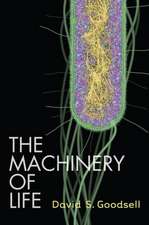Mycoplasma Cell Membranes: Subcellular Biochemistry, cartea 20
Editat de Shlomo Rottem, Itzahak Kahaneen Limba Engleză Paperback – 24 oct 2012
Din seria Subcellular Biochemistry
- 18%
 Preț: 948.79 lei
Preț: 948.79 lei - 5%
 Preț: 1456.88 lei
Preț: 1456.88 lei - 18%
 Preț: 1373.84 lei
Preț: 1373.84 lei - 18%
 Preț: 1243.78 lei
Preț: 1243.78 lei - 18%
 Preț: 2098.81 lei
Preț: 2098.81 lei - 18%
 Preț: 1122.10 lei
Preț: 1122.10 lei - 5%
 Preț: 1160.63 lei
Preț: 1160.63 lei - 18%
 Preț: 1396.26 lei
Preț: 1396.26 lei - 18%
 Preț: 1114.96 lei
Preț: 1114.96 lei - 18%
 Preț: 1224.68 lei
Preț: 1224.68 lei - 18%
 Preț: 951.29 lei
Preț: 951.29 lei - 18%
 Preț: 1227.99 lei
Preț: 1227.99 lei -
 Preț: 398.15 lei
Preț: 398.15 lei -
 Preț: 399.88 lei
Preț: 399.88 lei - 18%
 Preț: 1231.47 lei
Preț: 1231.47 lei - 18%
 Preț: 1230.35 lei
Preț: 1230.35 lei -
 Preț: 392.60 lei
Preț: 392.60 lei - 18%
 Preț: 1231.47 lei
Preț: 1231.47 lei - 15%
 Preț: 638.76 lei
Preț: 638.76 lei - 5%
 Preț: 656.26 lei
Preț: 656.26 lei - 5%
 Preț: 659.19 lei
Preț: 659.19 lei -
 Preț: 392.37 lei
Preț: 392.37 lei - 5%
 Preț: 662.09 lei
Preț: 662.09 lei -
 Preț: 395.09 lei
Preț: 395.09 lei - 5%
 Preț: 667.99 lei
Preț: 667.99 lei -
 Preț: 400.47 lei
Preț: 400.47 lei - 18%
 Preț: 1224.54 lei
Preț: 1224.54 lei - 15%
 Preț: 647.73 lei
Preț: 647.73 lei - 15%
 Preț: 646.75 lei
Preț: 646.75 lei - 5%
 Preț: 662.30 lei
Preț: 662.30 lei -
 Preț: 395.25 lei
Preț: 395.25 lei - 18%
 Preț: 1230.21 lei
Preț: 1230.21 lei - 18%
 Preț: 1231.95 lei
Preț: 1231.95 lei - 18%
 Preț: 964.54 lei
Preț: 964.54 lei
Preț: 389.49 lei
Nou
Puncte Express: 584
Preț estimativ în valută:
74.53€ • 77.81$ • 61.68£
74.53€ • 77.81$ • 61.68£
Carte tipărită la comandă
Livrare economică 05-19 aprilie
Preluare comenzi: 021 569.72.76
Specificații
ISBN-13: 9781461362692
ISBN-10: 1461362695
Pagini: 336
Ilustrații: XVI, 314 p.
Dimensiuni: 152 x 229 x 18 mm
Greutate: 0.45 kg
Ediția:Softcover reprint of the original 1st ed. 1993
Editura: Springer Us
Colecția Springer
Seria Subcellular Biochemistry
Locul publicării:New York, NY, United States
ISBN-10: 1461362695
Pagini: 336
Ilustrații: XVI, 314 p.
Dimensiuni: 152 x 229 x 18 mm
Greutate: 0.45 kg
Ediția:Softcover reprint of the original 1st ed. 1993
Editura: Springer Us
Colecția Springer
Seria Subcellular Biochemistry
Locul publicării:New York, NY, United States
Public țintă
ResearchCuprins
1 Mycoplasma Membranes as Models in Membrane Research.- 1. An Introduction to Mollicutes.- 2. Characterization of Mycoplasma Membranes.- 3. Elucidating Membrane Organization.- 4. Role of Membrane Components in Pathogenicity.- 5. Future Prospects.- 6. References.- 2 Mycoplasma Membrane Lipids: Chemical Composition and Transbilayer Distribution.- 1. Introduction.- 2. Lipid Composition of Mycoplasmas.- 3. Transbilayer Distribution of Lipids in A. laidlawii Membranes.- 4. Transbilayer Distribution of Sterols in Membranes of Mycoplasma Species.- 5. References.- 3 Physical Studies of Lipid Organization and Dynamics in Mycoplasma Membranes.- 1. Introduction.- 2. Physical Studies of Lipid Orientation and Dynamics.- 3. Summary and Conclusions.- 4. References.- 4 Regulation and Physicochemical Properties of the Polar Lipids in Acholeplasma laidlawii.- 1. General Features of A. laidlawii and Its Membrane.- 2. Basic Properties of the A. laidlawii Membrane.- 3. Biochemical Pathways and Chemical Structure of the Polar Lipids.- 4. Phase Equilibria and Structural Polymorphism of Lipids.- 5. Physicochemical Properties of the Polar Lipids in A. laidlawii.- 6. Regulation of the Membrane Lipid Composition.- 7. Physicochemical Interpretations of the Lipid Regulation Mechanisms.- 8. References.- 5 The Role of Cholesterol in Mycoplasma Membranes.- 1. Introduction.- 2. Mode of Sterol Uptake.- 3. Sterol Structure-Function Relationships.- 4. Sterol-Mediated Regulation.- 5. Concluding Remarks.- 6. References.- 6 Extramembranous Structure in Mycoplasmas.- 1. Introduction.- 2. Morphology and Electron Microscopy.- 3. Capsule Composition and Chemical Structure.- 4. Biological and Pathogenic Characteristics of Capsule.- 5. Concluding Remarks.- 6. References.- 7 Spiralins.- 1. Definition.- 2. Localization of Spiralin in Spiroplasma Cells.- 3. Properties of Spiralin as Deduced from Studies of the Protein.- 4. Properties of Spiralin as Deduced from Its Gene.- 5. Secondary Structure and Topology of Spiralin in the Spiroplasma Membrane.- 6. Spiralin and Prespiralin.- 7. Polymorphism of Spiralin.- 8. Spiralins in Spiroplasma Species Other Than S. citri and S. melliferum.- 9. Conclusion.- 10. References.- 8 Adherence of Mycoplasma to Cell Surfaces.- 1. Introduction.- 2. Morphological Studies.- 3. Adherence: The Molecular Aspects.- 4. The Mollicutes Counterparts: Adhesins.- 5. Molecular Arrangement of Adhesins in the Membrane and the Possible Role of the Cytoskeleton and Phosphorylated Proteins.- 6. The Advantage of Adherence to Mollicutes.- 7. Concluding Remarks.- 8. References.- 9 The Cytadhesins of Mycoplasma pneumoniae and M. genitalium.- 1. Introduction.- 2. Identification of Protein Adhesins of M. pneumoniae.- 3. Isolation of Cytadherence-Deficient M. pneumoniae Mutants.- 4. Characterization of the P1 Adhesin Gene of M. pneumoniae.- 5. Multicopy Nature and Sequence Divergency of the P1 Gene.- 6. Characterization of the 30-kDa Adhesin (P30) Gene of M. pneumoniae.- 7. The P1-Analogue Adhesin of M. genitalium.- 8. Characterization of Gene and Protein Sequence Homologies between the P140 Adhesins of M. genitalium and the P1 Adhesin of M. pneumoniae.- 9. References.- 10 Ion Pumps and Volume Regulation in Mycoplasmas.- 1. Introduction.- 2. Primary Ion Transport Systems.- 3. Secondary Ion Transport Systems.- 4. Electrochemical Potentials in Mycoplasmas.- 5. Volume Regulation.- 6. Concluding Remarks.- 7. References.- 11 Transport Systems in Mycoplasmas.- 1. Introduction.- 2. The Permeability Barrier.- 3. Sugar Transport.- 4. Amino Acid Transport.- 5. Fatty Acid Transport.- 6.Conclusions.- 7. References.









